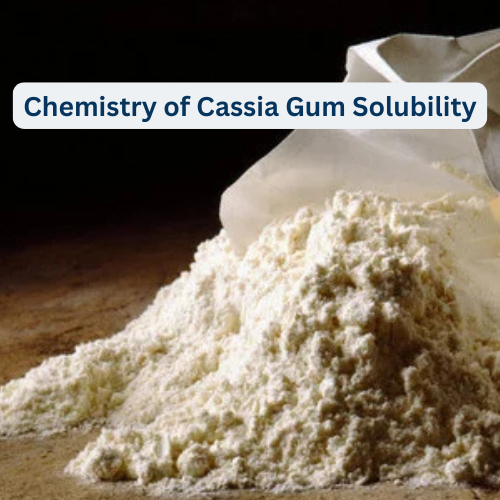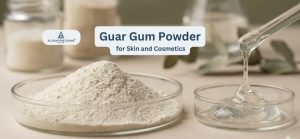
Why Heating is Essential in Cassia Gum Solubilization and Viscosity Development
Table of Contents
Cassia gum is a natural hydrocolloid extracted from the endosperm of Cassia tora and Cassia obtusifolia seeds, widely used in food, feed, pet food and industrial applications for its excellent gelling and thickening properties. However, the effective utilization of cassia gum powder critically depends on proper solubilization, which is strongly influenced by heating. Heating not only improves the dissolution rate but also activates viscosity development, which is essential for cassia gum’s functional performance. In this article, we explore the chemistry behind cassia gum solubility, the pivotal role of heating in viscosity activation, and best practices for heated processing in various industries.
1. The Chemistry of Cassia Gum Solubility
Molecular Structure of Cassia Polysaccharides
Cassia gum primarily consists of galactomannans—polysaccharides composed of a mannose backbone with galactose side groups. This unique molecular arrangement gives cassia gum its characteristic ability to hydrate, form gels, and increase viscosity.
- The mannose backbone provides structural rigidity.
- The galactose side chains contribute to solubility in water and influence gel formation.
- The interaction between these polysaccharides and water molecules is key to solubilization and viscosity development.

Importance of Water Temperature in Dissolution
Water temperature plays a crucial role in the hydration and solubility of cassia gum powder:
- At lower temperatures, cassia gum hydration is slow due to limited molecular motion and strong intermolecular hydrogen bonding.
- Heating water increases molecular kinetic energy, breaking hydrogen bonds and promoting faster and more complete solubilization of cassia polysaccharides.
- Optimal dissolution is achieved when cassia gum powder is dispersed in water, facilitating efficient hydration and dispersion.
Improper temperature management during solubilization can lead to uneven hydration, clumping, and poor viscosity, directly impacting the quality of the final product.
2. Role of Heating in Viscosity Activation
How Thermal Energy Helps Develop Functional Viscosity
Heating is essential not just for dissolving cassia gum but also for activating its functional viscosity, which defines its thickening and gelling performance:
- Thermal energy causes polymer chains to uncoil and interact, increasing molecular entanglement.
- This molecular interaction increases the viscosity of the cassia gum solution, resulting in a gel-like consistency.
- Without adequate heating, the polymer chains remain coiled and less interactive, resulting in low viscosity and weak gels.
Critical Temperature Thresholds for Gelling and Thickening
Studies indicate that cassia gum solutions must be heated to specific temperature thresholds to fully develop viscosity:
- Typically, the critical temperature for effective gelation ranges between 85°C and 120°C.
- Heating below this range may produce solutions with insufficient viscosity and poor gel strength.
- Conversely, overheating beyond optimal temperatures risks polymer degradation, which diminishes cassia gum’s functional properties.
Therefore, precise temperature control during processing is vital for maximizing viscosity and gel strength.
3. Industrial Applications Requiring Heated Processing
Usage in Pet Food, Dairy Analogues, and Meat Emulsions
Cassia gum’s versatility is reflected in its widespread application across various industries, many of which depend on heated processing to optimize its functional benefits:
- Pet Food Industry: In wet pet food formulations, heating cassia gum powder in water ensures thorough dispersion and hydration, resulting in improved texture, moisture retention, and product stability.
- Dairy Analogues: Plant-based milk and yogurt alternatives utilize cassia gum as a thickener and stabilizer. Heated solubilization ensures that the cassia gum develops sufficient viscosity to replicate the mouthfeel and creaminess of dairy products.
- Meat Emulsions: Cassia gum acts as a binder and water-holding agent in processed meat products. Heated processing enables the gum to develop gel structures that bind fat and water effectively, enhancing yield and texture.
Heating Protocols for Optimal Solubility and Performance
To achieve consistent performance, industrial processing of cassia gum powder involves standardized heating protocols:
- Gradual temperature increase prevents premature gelatinization or polymer degradation.
- Maintaining the solution at the target temperature for a specific holding time allows complete hydration.
- Continuous agitation during heating ensures uniform dispersion and prevents lump formation.
- Cooling protocols after heating preserve the viscosity and gel strength required for final product formulation.
4. Common Issues Without Proper Heating
Low Gel Strength, Poor Hydration, and Viscosity Instability
Failure to apply adequate heating can result in multiple processing and quality issues:
- Incomplete Hydration: Cassia gum powder does not fully dissolve, causing lumps or sedimentation in the solution.
- Low Gel Strength: Gels formed are weak and lack the desired firmness, compromising texture and stability.
- Viscosity Instability: Unheated or improperly heated solutions may show viscosity fluctuations, affecting consistency during production.
Quality Inconsistencies in End-Product Applications
Insufficient heating during cassia gum processing can lead to poor product quality and reduced consumer acceptance:
- Syneresis (water separation) in gels and emulsions.
- Reduced binding and water retention in meat products.
- Texture defects and phase separation in dairy analogues and pet foods.
- Overall reduced shelf-life and compromised sensory attributes.
5. Best Practices and Equipment for Heating Cassia Gum
Controlled Heating Systems in Food and Feed Production
Modern food and feed manufacturing plants employ specialized equipment designed to optimize cassia gum solubilization:
- Jacketed Mixing Vessels: Provide uniform heat distribution with precise temperature control.
- Inline Heat Exchangers: Allow continuous processing and heating with minimal temperature variation.
- Automated Monitoring: Ensures strict control of time and temperature parameters to maintain product consistency.
Time-Temperature Optimization and Agitation Methods
Efficient heating protocols are essential for maximizing cassia gum powder’s functional benefits:
- Optimize heating time to balance complete solubilization with polymer stability.
- Use high-shear mixers or agitators during heating to prevent clumping and promote homogeneous dispersion.
- Implement real-time viscosity monitoring to ensure heating parameters produce the desired gel strength.
Conclusion
Heating plays a fundamental role in the solubilization and viscosity development of cassia gum powder. By understanding the molecular chemistry of cassia polysaccharides and applying precise thermal energy during processing, manufacturers can unlock cassia gum’s full potential as a gelling and thickening agent. Proper heating protocols improve product texture, stability, and consistency, essential across pet food, dairy analogues, meat emulsions, and other food and feed applications. Incorporating controlled heating systems and optimized agitation methods ensures high-quality, reliable cassia gum performance in industrial settings.
FAQs on Heating and Cassia Gum Solubilization
Why is heating necessary for cassia gum powder solubilization?
Heating accelerates polymer hydration and ensures complete dissolution, which is essential for viscosity development.
2. What temperature range is ideal for activating cassia gum viscosity?
Typically, heating between 85°C and 120°C is required for optimal gelation and thickening.
3. What problems can occur without proper heating of cassia gum?
Issues include incomplete hydration, low gel strength, viscosity fluctuations, and poor product texture.
4. In which industries is heated cassia gum processing commonly used?
Heated processing is crucial in pet food, dairy alternatives, meat emulsions, and various feed applications.
5. What equipment is recommended for heating cassia gum powder?
Jacketed vessels, inline heaters, and agitators with precise temperature and time controls are best.
6. How does agitation improve cassia gum solubilization during heating?
Proper agitation prevents clumping and ensures uniform polymer dispersion, improving gel and viscosity quality.

CEO, Altrafine Gums
With over Four decades of expertise in the natural gums and hydrocolloids industry, Ajit Patel leads Altrafine Gums, a globally recognized manufacturer and exporter of Guar Gum Powder, Cassia Tora Powder (Cassia Gum Powder) and other Hydrocolloids. Under his visionary leadership, the company has built a strong reputation for quality, innovation, and reliability across the food, feed, pet feed, pharmaceutical, mining, oil drilling and cosmetic sectors.
Altrafine Gums has been serving global industries for decades with a focus on sustainable sourcing, research-driven production, and stringent quality control. Its wide product portfolio includes Guar Gum Powder, Cassia Tora Powder (Cassia Gum Powder) and other plant-based hydrocolloids that serve as key functional ingredients in diverse applications.
Ajit Patel’s commitment to excellence ensures that every product from Altrafine meets international standards of performance and purity. He is passionate about advancing the global reach of Indian hydrocolloids, fostering customer trust, and promoting eco-friendly, science-backed solutions that enhance product formulation and performance worldwide.








